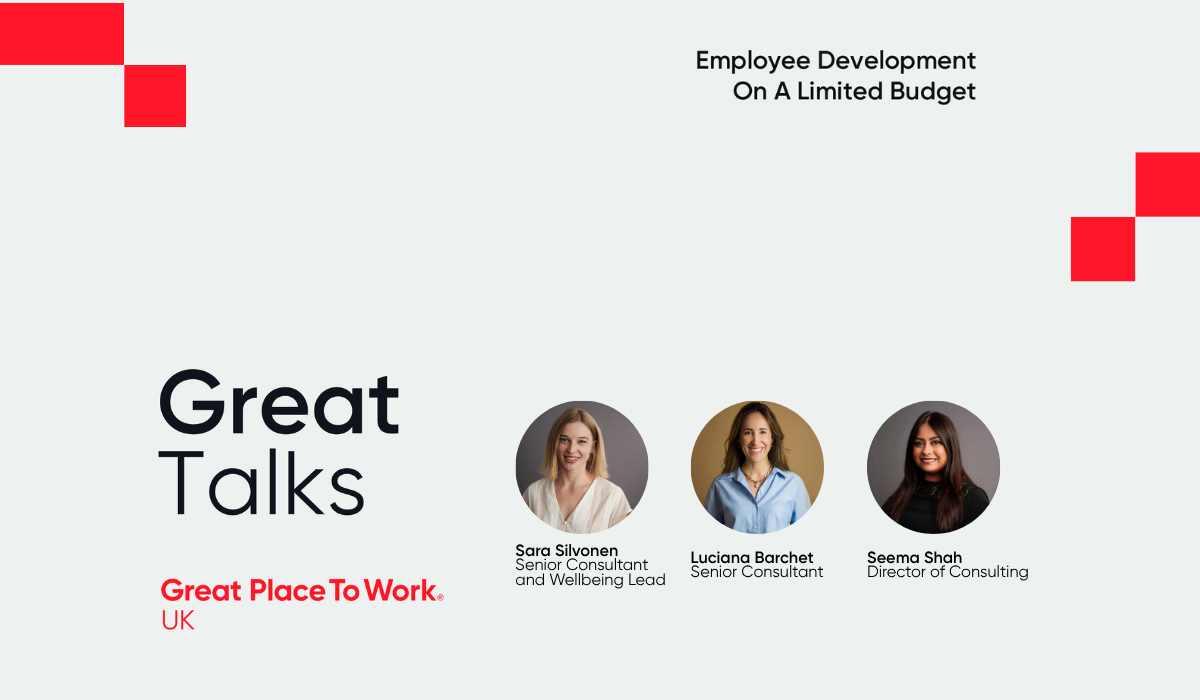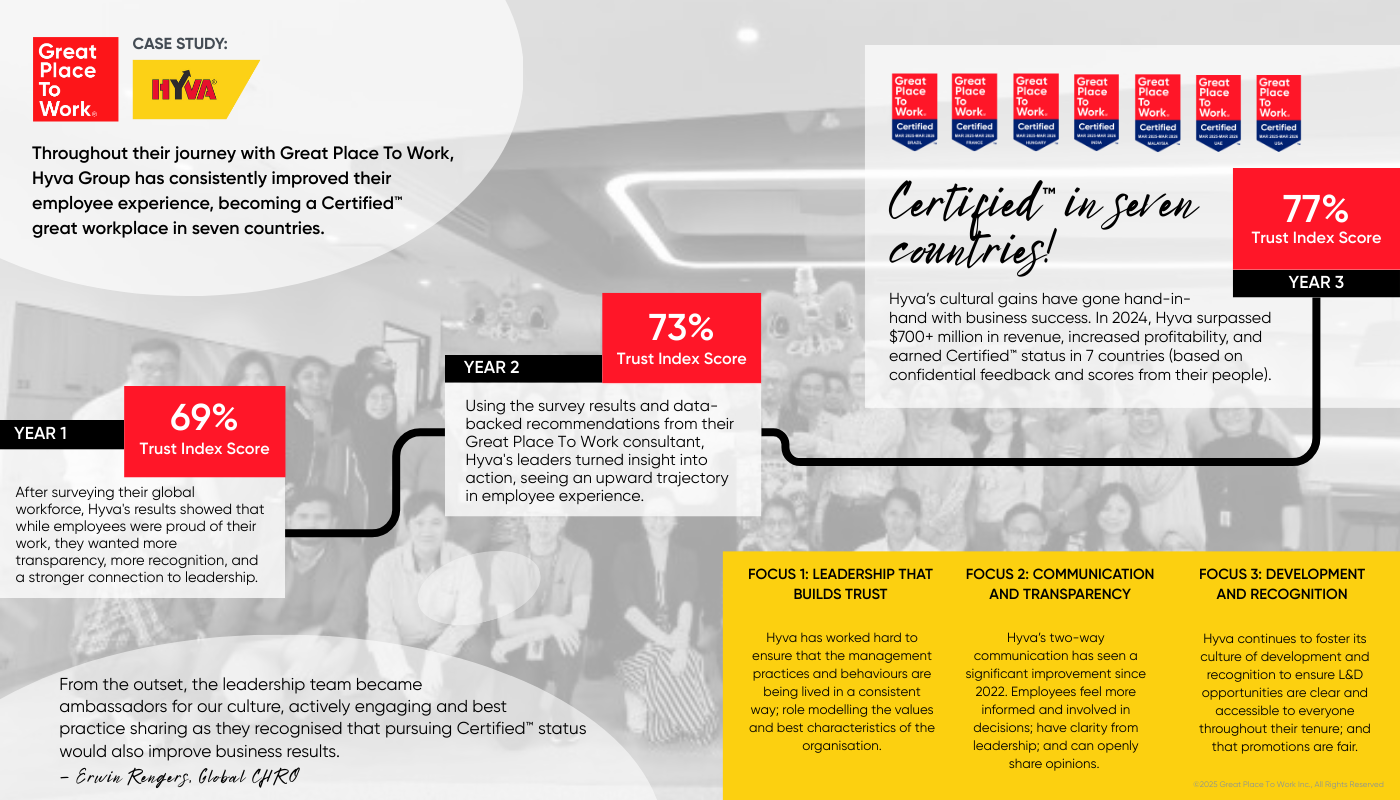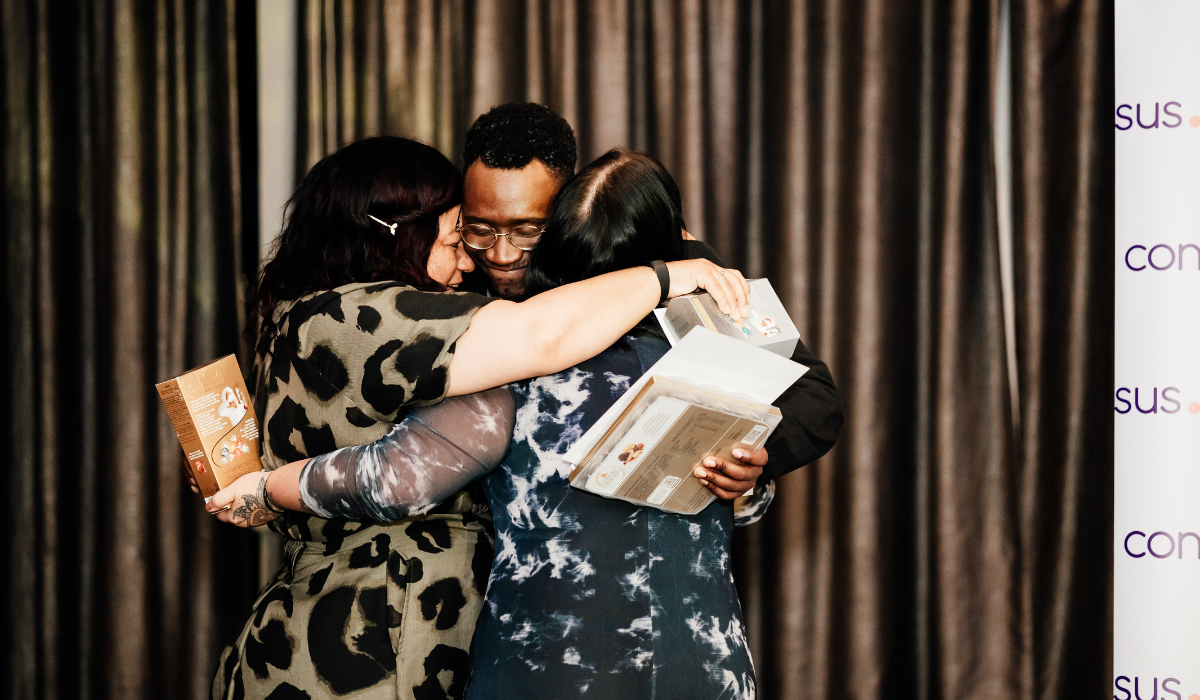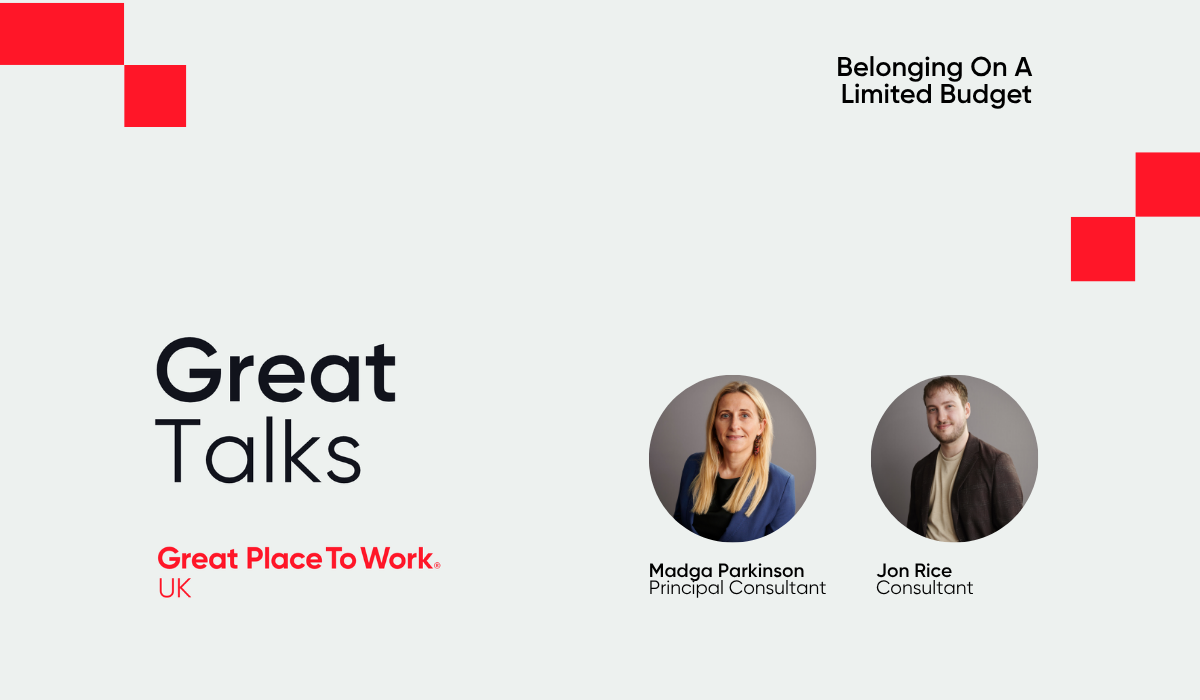Join us as we discuss practical strategies and insights on how to foster employee development without breaking the bank.
Listen to Episode 1: Employee Wellbeing On A Limited Budget here
We know that many organisations share a common challenge: how to build and sustain a great company culture without the need for major financial investment.
But we believe every workplace, no matter their size or budget, can become a great place to work. In our new podcast series, On A Limited Budget, we'll be sharing tips and insights on how even the most budget-conscious businesses can create a healthy, happy, and productive workforce
In our second episode, we're exploring one key element of this critical challenge: fostering employee development without breaking the bank. Listen below as Great Place To Work UK Senior Consultant and Wellbeing Lead Sara Silvonen, Senior Consultant Luciana Barchet and Director of Consulting Seema Shah dive into ways you can support employees to better themselves, learn new skills, and progress within the organisation.
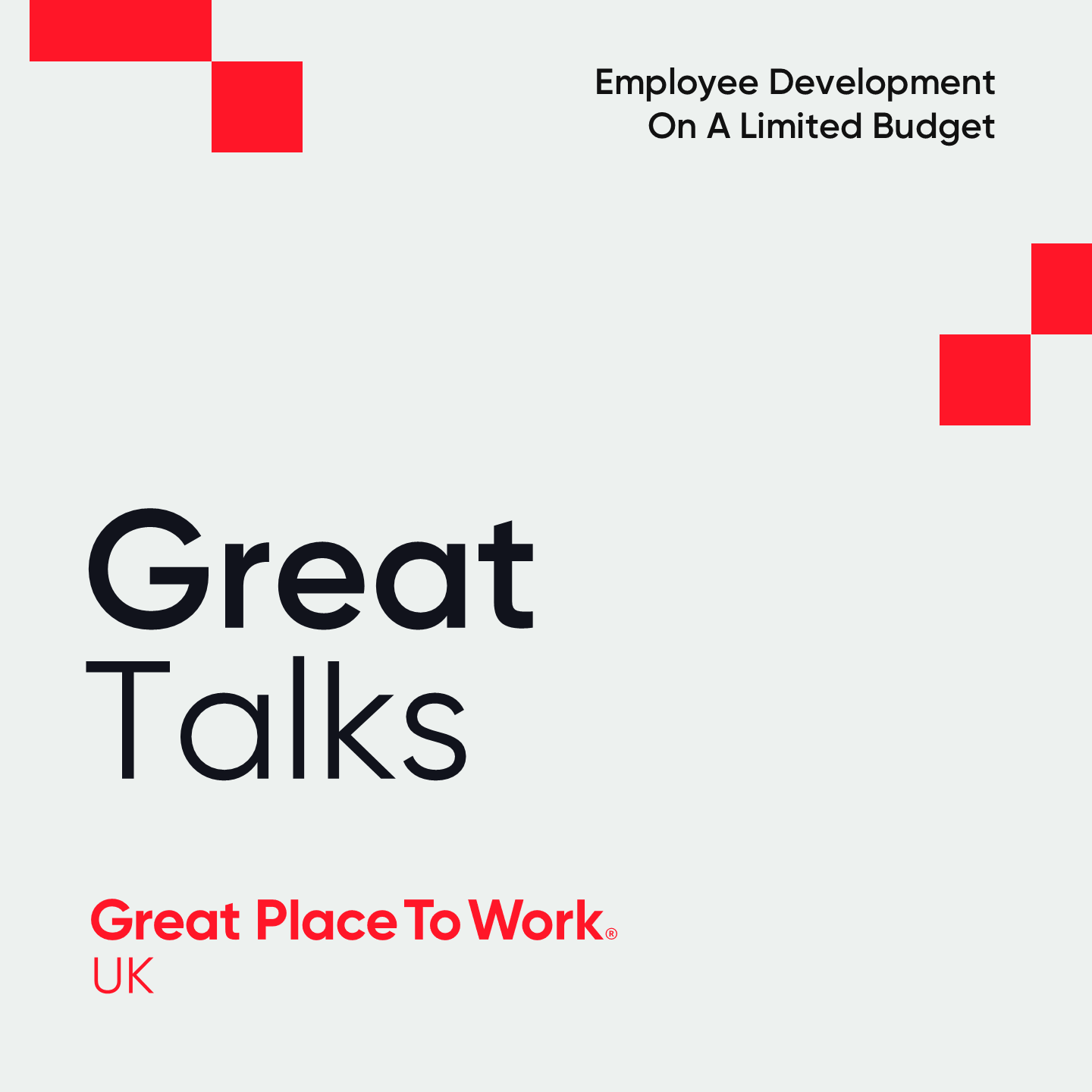
Key Takeaways
The business benefits of employee development
Development isn't just a nice to have – it's a vital piece of building a thriving business. As Luciana explains, boosted retention and engagement are two of the benefits of investing in development:
"What happens when we have this scenario of higher retention and more engaged employees? They are more invested and committed to their jobs, so they are more productive, and it should come as no surprise that this will also reflect in higher profitability for the company."
As Seema adds, organisations that prioritise development will also be the ones who are prepared for the future of work: "Technology has such a big impact on everything we do. For companies who aren't keeping up to date with that, or even ahead of the curve, they can very much fall down. It really impacts on their bottom line, how they are moving forward as a company as well. Thinking about that skills gap that we might have for the future is going to be really important for the bottom line and for the organisation overall."
Utilising internal resources
One of the easiest ways for organisations with a limited budget to foster a culture of development is to utilise their existing employees, says Sara:
"I'd say a huge part of development is just leveraging the wealth of internal knowledge, skills, capabilities that you probably already possess as an organisation. So, really trying to tap into that by encouraging people to upskill each other. This could look like job shadowing. It could be a day in the life, cross-departmental upskilling initiatives, diversifying.
And that's not only one way to break silos and improve collaboration across the organisation, you're actually also helping fill any skills gaps. You're sort of future-proofing your organisation a little bit that way."
Development for all
Development shouldn't be exclusive, explains Luciana: "when opportunities depend on favouritism rather than fairness, the trust erodes and the diversity of the workforce suffers as well.
So, consistent, inclusive management is critical to equitable growth within the organisation. It's important that this culture of development is supporting the business strategy and the career progression of every individual employee, because it should be for all."
Show Transcript
James: Hello, and welcome to On a Limited Budget, the series where we explore how you can build a thriving workplace culture without breaking the bank. I'm James, Lists and Organisational Trends Manager at Great Place to Work UK, and I'll be your host today.
Great Place to Work is the global authority on workplace culture. Every year we get direct feedback from over 10 million employees around the world, working across a range of companies in various industries and sizes, telling us how they really feel about their employer. Diving into the data, we noticed that many organisations share a common challenge: how to build and sustain a great company culture in a way that's cost effective but still impactful. Today, we're exploring one key element of this critical challenge: enabling employee development on a limited budget.
Employee development is a vital component of crafting a dynamic, thriving workplace culture, and it's a must-have for recruitment, retention, and engagement. I'm joined by Director of Consulting, Seema Shah, and Senior Consultants, Luciana Barchet and Sara Silvonen. During our conversation, you'll hear Seema, Luciana, and Sara share some practical strategies and insights on how to encourage knowledge sharing, breed innovation, and empower employees to take control of their own growth journey.
Join us as we explore employee development on a limited budget and discover how even the most budget-conscious businesses can support employees to better themselves, learn new skills, and progress within the organisation.
So, Luciana, you're very familiar when it comes to development in workplace culture, you've spoken about it previously at our For All Community events, so I'd actually love to kick off this conversation with you, just by quickly sharing with us, how do we at Great Place To Work define development?
Luciana: Hi James, hi everyone, it's a pleasure to be here today. So, yeah, the concept of how we look at development around the employee experience is based on four essentials that work as the foundation supporting and giving stability for people to develop and grow.
So, these are the essentials that we basically measure and recognise the Best Workplaces for Development at Great Place To Work. Number one, by providing the training, the resources, and the opportunities for development: that can be through training, that can be through mentoring and career planning. So, the success here lies in balancing the business goals with the individual aspirations.
So, this is the number one essential of a culture of development, of a culture of continuous learning. The number two of the essentials that we look at in our model is pretty much empowerment. So, here we're talking about allowing people to feel empowered and that they have the autonomy to do things on their own, basically to learn by doing, to learn on the goal, right, of doing things.
And then after people are empowered, so how do we recognise these people? This is one of the key essentials of a culture of development. We're talking about that people need and they want to be recognised for the work that they are doing and to feel that they are appreciated for doing a good job. So, basically here, acknowledging the effort fosters that culture of growth.
So, when employees feel valued, they are more likely to invest in their development and the recognition piece also helps organisations to spot these trends, to spot gaps, and also to, you know, to identify their talent pipeline.
So, how do we do all of things? We have these key essentials, but how does that work? So, here we bring the managers that play a key role in fostering that culture of development, and this is why we talk here about the management essentials. So, the manager behaviour can make or break development, right? So, when opportunities depend on favouritism rather than fairness, and here is one of the key core statements that we have in our survey, right? “Promotions go to those who best deserve them.” So, how do we bring that culture of fairness that managers, they don't work with any type of favouritism because the trust erodes and the diversity of the workforce suffers as well. So, consistent, inclusive management is critical to equitable growth within the organisation. So, basically these are the four essentials.
We start providing the development, we empower the people, we recognise, and then we have a consistent experience for everyone with their managers being the key drivers of that culture of development as well.
James: No, absolutely, and I think it's really interesting that you're able to share a little bit about how that development is broken down, and actually it's so multifaceted. One thing you actually touched on, which I'd love to get a little bit more information on, is you mentioned about some of the benefits in terms of identifying sort of talent pipeline when it comes to development, and what I wanted to actually expand on is actually why is development so important in workplace culture?
Luciana: So, I mean, we have a lot of studies that reinforce that, and you know, some of these studies, they show a strong correlation between employee development and its effect on a company's bottom line.
So, if you want to bring some numbers here, just to bring this story a little bit to life as well. So, 94% of employees, they are going to stay longer if their company invests in their career, right? This is, if you think about that, this is a huge number when you're thinking about employee retention, and it shows us this strong relationship that developing your people has basically on their desire to continue working for your company for longer. So, studies also show that companies that invest in people development, they have employees four times more engaged and satisfied with their job.
So, what happens basically when we have this scenario of higher retention and more engaged employees? So, basically, they are more invested and committed to do their jobs, so they are more productive, and it should come as no surprise that this will also reflect in higher profitability for the company.
Seema: Yeah, and I think just to build on that, actually, one of the stats that we've seen is that actually 90% of employees who are on our organisations that are on our UK’s Best Workplaces for Development list, they say that they give extra to get the job done. So, really put that discretionary effort in, and this is actually quite significantly different to when we compare this to the average UK workforce who say only 67% of their workforce would say employees would give extra.
So, there's a real kind of impact there from that discretionary effort as well. I think the other thing outside of looking at some of those stats as well, I think where it's a real, why it's so important is that technology has such a big impact on everything we do at the moment. And I think for organisations or companies who aren't keeping up to date with that, or even ahead of the curve, they can very much fall down.
So, again, it really impacts on their bottom line, how they are kind of moving forward as a company as well. So, I definitely think supporting your employees to really think about how we're upskilling them, and thinking about that kind of skills gap that we might have for the future as well, is going to be really important for the bottom line and for the organisation overall.
James: Absolutely. And I think one thing I really like there is actually how many different types of benefits an organisation can get, not only just for their employees themselves, in terms of making sure that they feel empowered, they can be more productive, they're more motivated, but also that retention aspect and actually how much it can grow an organisation from having those employees who are developing. So, we can see actually from discussing it that it's worth the investment to put time into development within the workplace.
But of course, what we're speaking about today is it is difficult for a lot of different organisations to invest in development. So, one thing I really wanted to touch on is when it comes to what we do and the types of companies we work with, we work with a range of organisations from small all the way to really large organisations. But we also work with organisations across industries that don't always have that budget to use to be able to invest in development itself. So, Sara, I'd actually love to get your perspective on this initially. Could you actually just give some examples of different ways in which clients you've worked with have implemented development on a limited budget?
Sara: Thanks, James. Yeah, I mean there's a lot of ways to go about this. Firstly, I'd say a huge part of it is just leveraging the wealth of internal knowledge, skills, capabilities that you probably already possess as an organisation. So, really trying to tap into that by encouraging people to upskill each other, as it were. So, this could look like job shadowing. It could be a day in the life, sort of cross-departmental upskilling initiatives, diversifying.
And that's not only one way to sort of break silos and improve collaboration across the organisation, you're actually also helping with that skills gap, like Seema mentioned. You're sort of future-proofing your organisation a little bit that way. And at the most kind of basic level, you could just have an internal kind of skills database or repository.
So, just knowing who has expertise in what, basically knowing where to go for if you want someone to tutor you on a specific set of skills, for example, around Excel or R, blog writing, design, thought leadership on some subject matter, etc. Then if we're talking sort of severe budget restrictions, there are a wealth of free resources out there, of course, that you could always look into. There's so many conferences, training programmes, events, webinars, e-learning, you name it.
For example, our team, the consultants at Great Place to Work, we went to the two-day Festival of Work conference last year, organised by the CIPD and plan to go again this year. And that was a really lovely way of sort of upskilling as a team, taking time out to do it and discussing our learnings with each other as we went through it. And then the other thing I'd say is if you're on a budget, it's always worth, for something that's not free, maybe sending one person out, getting them to come back and upskilling the rest of the team in that.
So, for example, if we do training around facilitation or presentation skills, we can always sort of upskill each other through that. And that's one way to consolidate that learning as well. And then the kind of final thing I'd say is if you are struggling to give people budget for their development, it doesn't have to be sort of monetary, a financial budget.
You could give them time or headspace to go about their development. And that can be through having the right kind of managerial conversations and sort of empowering people, getting them sort of ring-fenced time in their diaries to really focus on development.
Seema: Thanks, Sara. Some really great examples there. And I think just building on the coaching and the mentoring side, one of the examples from a previous life, a previous job that I was at, an initiative called the Shadow Board that was set up. And this was a really kind of, I guess, way of reverse mentoring, but also kind of upskilling your kind of future leaders as well.
So, it was a great way of bringing in sort of your junior or mid-level employees where they had this program that the leadership team would invite people to join a Shadow Board, essentially. Each leader would interview the individuals and then they would have some sort of exercise as well. So, it was a bit like kind of getting onto a graduate program.
So, but actually, those people who did then become part of the Shadow Board, it was a real privilege for them and it raised their profile. But the opportunities they got through that were sort of immense in the sense that they were able to have monthly meetings with directly with the CEO, they would sit on some of those leadership meetings.
So, they would hear firsthand some of the sort of challenges that leaders come up against. But also, I guess that from that reverse mentoring perspective, leaders were also able to bounce off ideas with this group as well. So, I guess in terms of some of the skills and knowledge that they might bring in from a sort of different generational perspective as well, was a real opportunity for the leaders to kind of get something.
So, I think that was, it was a really nice way of, you know, I guess, increasing visibility for leadership, but that whole development piece, not just for our frontline employees or mid-level employees, but also for the leaders in the business as well.
James: I actually would love to build on that a bit more because I think that's really interesting. And I think when often people think about development, there's such a misconception of thinking development is from the top down - you are an employee trying to work your way up and start to learn and develop in that way. But actually, with that example, we can see that development is such a two-way street. Leaders can learn from employees and employees can learn from leaders.
That can lead to innovation, creativity, and also taps into the essential that you were talking about in terms of empowerment, feeling that time to be able to connect with leaders and be able to share your perspectives. I think it's a really interesting example that you're able to share.
Seema: Definitely. And I think, I think what this really shows is that it's about, it's much more holistic. I think that whole, all these different touch points that people can go through, you can think about growth, learning, it's that whole concept around continuous learning. Essentially, even if you're a leader, you're still learning every day and going in with that open mindset, I think.
Luciana: Yeah. So just to build up on that, when you're talking about empowerment, going back to the key essentials of the model, right? So when we analyse the data from the Best Workplaces for Development versus our population study, for example, as a comparator, we see that the empowerment essential, this is the one that we have the highest score for both data sets. But what is interesting to see around this data as well is that when we break down these scores or these results across different core demographic groups, such as gender, age, managerial level, we see by age, for example, that the younger generation or the Gen Z is the least positive one around empowerment.
So I think what Seema just mentioned about having that visibility from the senior leadership, when we have these two ways of learning and continue growing, this is a good way that this younger generation can be exposed to more mature conversations, to be involved in more senior forums as well, to learn and to feel more empowered to continue their career growth, to continue their learning as well. So I think this is the key thing that we have this multi-generational workforce for the first time now, right? So we have like an age range, if we could say sometimes of nearly 50 years old, right? So as no other generation has experienced this before in the workplace, this is something that we're having for the first time. So how do we make sure that we are supporting and empowering that younger generation? Because this is where you have the future leaders of the organisation, right? This is where you're getting the pipeline of talent to build the leaders of the future as well.
So pretty much learn by doing, feeling that they are given the autonomy and to learn more from the senior colleagues.
James: No, absolutely. And I think this is one thing that we can really kind of talk about. And actually what you raise is so important. I think when we reflect on that sort of multi-generational aspect of workplace culture, when it comes to the younger generation coming into the workforce, historically, we had the opportunity to be able to learn vicariously by being around senior leadership and being in that room together and listening to conversations and listening to those interactions, being able to develop from that. And having something like the shadow board in place gives the opportunity for those who are maybe working from home or maybe a hybrid working and aren't in the office all the time to be able to have that connection with leadership and be able to build those relationships and then have that two-way learning capabilities.
But I think it's actually really interesting to build on that, to think about actually how else can organisations utilise their employees in this way to be able to support not only the development but the organiation itself?
Seema: Yeah, definitely. I think a lot of organisations are bringing in communities of practice often, and I guess now more so calling them employee resource groups. And that's a real benefit for organisations in terms of bringing maybe cohorts of different groups of people together.
But actually what this is also enabling organisations to do is actually create real opportunities of innovation.
Luciana: Yeah, I think this is very interesting. We just came back from the GPTW Summit in Las Vegas, and a lot was mentioned about the ERGs, the employee resource groups.
We talk about inclusion groups, associate groups, cultural ambassadors, you name it, in different ways, in different companies. Here, at Great Place To Work UK, we call them working groups, right? So I think just linking to what Seema said, these communities of practice, right? And we go back to the younger generation again. So this is the place, this is the space that they have to build their own communities, their own communities as well.
And in essence, an ERG is an incubator for leadership because if you can mobilise a group of people to come with a common practice together, so in essence, you are a leader, right? So this is very important, you know, to build the futures and to give that voice and that empowerment for everyone within that particular community, or especially for the younger generations as well.
James: Absolutely. And I think what I really like about this is actually just talking so much about how we can utilise our employees to kind of help not only just create change, but implement changes for a range of things, but especially for development.
And I think this raises another question when it comes to how we utilise employees to support each other. Because one thing that I think a lot of organisations struggle with in terms of how we actually instill empowerment in employees, to be able to support them, to be able to be wanting to develop and putting that effort and energy into this. So Sara, actually just to redirect to you, because obviously this is something that you mentioned in terms of using your employees initially to help upskill each other, how as an organisation can you inspire your own employees to take ownership of their own development?
Sara: Yeah, it's a great question. I'd say there are sort of two major avenues here that work best in tandem. The first is by kind of embedding learning and development into basically all other areas of the employee experience. So into your internal performance management, into your PDPs, your promotion, your recognition, your collaboration processes, your communities of practice, your ERGs, like we've just been talking about.
So linking all that to development and essentially incentivising and rewarding it. Just as a bit of a personal example from our own workplace, one of our most arguably prestigious internal awards is in the name of our beloved late colleague for whom lifelong learning was a really important pursuit. So we basically award someone each year who has prioritised their own development and sort of brought that back and applied it to their job and to our organisation.
And we award it in the name of our beloved Phil Wilson. So that's one really powerful way for us to sort of show how much we prioritise learning and development internally and how we basically become a learning organisation rather than trying to tick a box. We're trying to show that it's a deep rooted sort of strategic priority rather than just a set of training programs or anything like this.
And then the second one, which like I said earlier, is arguably the best way to give people that time and headspace if you don't have the sort of monetary budget for development is through people management behaviours and really empowering direct reports to proactively drive their own development, having really good, effective, regular conversations about how people want to develop and how they see that process going for them.
But then also by role modelling that behaviour themselves as managers, as leaders. Like we said earlier, it's also about reverse mentoring. It's about leaders continuously learning. It's not just the sort of younger or newer employees or the more junior employees who want to develop. It's everybody. So really role modelling that from the top, I think through those people management behaviours.
Seema: Yeah. And I think just building on that and just something I thought about was that actually a lot of people have these side hustles as well.
And actually the kind of knowledge and skills that they have through those can really very much be brought into the business. So it goes back to the line manager really understanding and knowing their direct reports, that relationship they have and what really motivates those individuals. So a hundred percent in terms of those management capabilities around getting and empowering, inspiring individuals, having those good conversations is so key. Yeah. And just making sure that essentially employees can also feel that they can be themselves at work. So whether they do something outside, how can they actually use those capabilities within the business to help grow the business? And I think that’s a really, really innovative way as well of bringing sort of new ideas to the table.
James: I think that's really important. And one thing I wanted to say on that is that I've been reading a lot recently, things that I've been seeing just within the HR space around having talent marketplaces within your own organisation. So not only as you mentioned, your manager understanding the skills and capabilities that you possess, but also having a talent pool that others within the organisation can then utilise by going to certain people who maybe have specific skills in maybe designing or if it comes to programming or if it's Excel or if it's building a deck and actually knowing who you potentially could go to and having this resource of places that you can almost pinch other people from other departments and teams to be able to help and support each other. Not only is going to utilise your internal talent resource, but means you can then upskill each other perfectly through that.
Seema: Definitely. And I think that's just such a great way of showing a culture of collaboration. But I think also when it comes to thinking about what are we trying to achieve as a business and what's our kind of strategic narrative, everyone can then understand, well, what am I doing to help support that? And not just in their own vertical kind of team, but actually across the business as well.
Luciana: I think just one thing going back to those management essentials as well, that we talk a lot about leadership behaviour. So how are we supporting our managers and our frontline managers as well? Because how are we expecting that this group of people are going to be able to empower and recognise their own direct employees and they don't have that behaviour coming from the top as well. So there's a lot around that inspiration from the top going on. So when we look at something around our studies as well, we're going to talk about promotions. We're talking a lot around the development, the culture of learning, that collaboration, that supporting each other to supporting the business strategy as well.
But ultimately some of the employees are going to be thinking, okay, how this is going to impact or affect my career progression here? And this is where we bring our population study that when we're talking about promotions going to those who best deserve them, and we analyse these results by length of service, we will see that employees working for longer within the organisation, they are much less positive about career progression and career opportunities. So going back to that culture of learning and development here, we pretty much need to understand how managers are having conversations with their employees around their progression, how they're facilitating these conversations through their personal development, their PDPs, their personal development plans or professional development plans, right? And pretty much how do we define and redefine what success looks like in my career working here for this organisation?
It's not always a ladder. You don't always need to move upwards. It can be a lattice as well. It's like, imagine like a chessboard, right? That you can move a little bit, you know, you can move to another department, you can make a lateral movement. Let's say it doesn't always need to be upward.
So how all of this culture of development is supporting the business strategy and the career progression of every individual employee, because it's for all, right? A key part of our model, of our methodology.
Sara: Yeah, I guess it's kind of about finding that sweet spot between individual interest and skills and capabilities and the business needs, the organisational needs.
James: I'm really glad you mentioned about the career development in terms of not seeing it just as linear, or as we mentioned, going up the career ladder. It is something that takes different routes for different people. And it actually happens at different times as well.
I think people often feel the pressure to be developing at a certain speed in a certain way, but actually development can take so many different forms and take so many different routes and have so many different types of support at the same time. And what you mentioned about the role modelling aspects and having managers showing how to develop and supporting them with that development and having those resources in place from leaders to help with that development is really important. And I think speaking of leaders here, I think a lot of those who are listening will be really interested to know a little bit more about when it comes to implementing these types of development initiatives or schemes, how are we going to know if they're successful? How are we going to know that what we're implementing is going to have a tangible impact on employees perceptions and ability to develop? So Seema, I'd actually love to position that question to you. How would you actually measure success when it comes to development in the workplace?
Seema: No, it's a great question. You know, anything you do, every leader wants to measure it and how successful it is. So I mean, you know, fundamentally, one of the key ways to do it is referencing back to our development model and the essentials, running a Great Place to Work survey.
Through that, there are key statements within that, that very much holistically look at development and how you're progressing around that. So I think the Trust Index is a key way to look and focus on measurement. But there's so many other things to think about.
I think definitely the PDPs, going back to those and setting really clear objectives and that are measurable, having those kind of KPIs then linked to those objectives is really important. But also that obviously goes back to how good those conversations are as well with managers. So I think, you know, the PDP process is going to be fundamental.
But also I think just thinking about when people are, it's that real time kind of recognition and feedback as well is really important. So a bit more kind of organically thinking about how we're sort of measuring success as well. I think if we're thinking more big picture as well and long term, what you will see, you can look at that through maybe retention rates and obviously not wanting to lose your talent pool.
But I guess again, seeking that sort of that ROI. Are you innovating as a business? Has all these kind of different initiatives that you've put in place, this culture of learning really helped to bring the business forward? And I know that can take a bit longer to sort of measure and have different factors that impact it as well. But I think, you know, developing this culture of learning is going to be key in terms of how we perform as an overall business as well.
James: We have shared so many rich insights and so many different great examples of things that organisations can start to implement or even redefine within their own workplace to really support development. And I think what listeners already want to know is from each of you as experts within this field, if you were to give people leaders just one initial step to focus on when it comes to implementing development on a limited budget, what would it be? And I open the floor to anyone. I guess,
Seema: Yeah, from my perspective, I think first thing would be really understand your people, understand the skills that they hold, not just for the job that they're currently doing, but what they could be doing for the business in the future.
So really understanding the skill sets that you have across the business and how effectively you could then leverage that to achieve your objectives as an organisation.
Luciana: Yeah, I think the development thing, it's a continuous and evolving type of thing, right? It's not an end project that you implement, let's give training for everyone, then it's finished, then in two years’ time, we talk about that. It's pretty much, it's a never ending process of defining and redefining who you are as a business and which are the key essentials that are going to be supporting the business to continue to grow.
Sara: I would just say, be wary of ticking the development box, because there's nothing worse than doing CPD for the sake of doing CPD, especially if you're on a limited budget, and especially if it's going to be time consuming for people and not even particularly useful for them or the organisation. In fact, that's just going to actively irritate them because you're taking time away from their probably very busy working lives. So instead, think strategically of how you can create that kind of infrastructure to really tap into that sweet spot, like I said, of what people want to do, what they're interested in, where they can provide unique value that's also going to benefit the organisation, not just the individuals in the short term and in the long term.
Arguably, the best way to start tapping into that sweet spot is to get people managers comfortable having those conversations, getting that information out of them, having questions, asking the right questions in their one to ones in their PDPs, and so forth.
James: Incredible. Thank you so much for sharing those insights. I know everyone will be absolutely fascinated by all the different examples that you've all shared. And thank you for joining me today and actually opening up this conversation and talking about it in such a new and insightful way and a bit different to what people would usually typically expect when it comes to speaking about development and giving those really rich examples.
So thank you so much. And to our listeners, hopefully you've gained some helpful tips and inspiration for how you can support employee development on a limited budget. Thank you so much for tuning in. Make sure you're subscribed wherever you get your podcasts and sign up to our newsletter so you get notified when our next episode is live, where we'll be talking about equity and inclusion on a limited budget.
And to find out more about how we can help you measure and improve your company culture, visit us at greatplacetowork.co.uk
